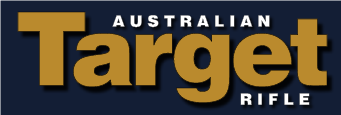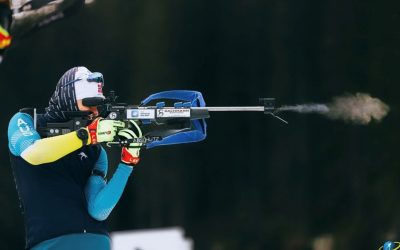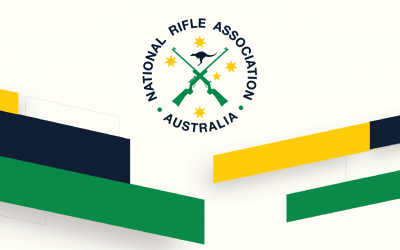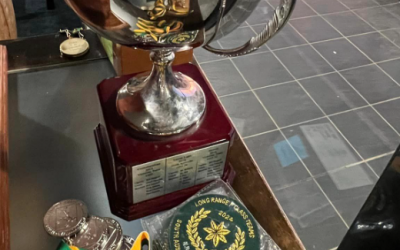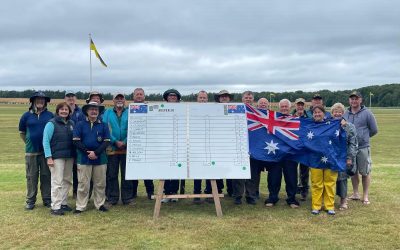The position of National Rifle Association of Australia (NRAA) President is not permanently established via the NRAA Constitution. Section 14 of the Constitution (dated November 2013) states:
“The Company may at its discretion and from time to time appoint a Patron, Vice-Patrons, President and Vice-Presidents none of whom shall be members of the Board.”
The current Constitution outlines that the NRAA Council will appoint the President annually. The process that is generally followed is the NRAA Board recommends to the NRAA Council an individual of suitable standing to be considered for the appointment of NRAA President.
A question asked in recent times is “why does the NRAA have a President and what is the President’s role?” To inform the discussion, this article provides the history behind the appointed President’s position.
BACKGROUND
History
Kilsby, in his book ‘The Riflemen – A History of the National Rifle Association of Australia 1888-1988’, uncovers the evolution of what is now known as the NRAA. Importantly, Kilsby outlines the specific leadership and broad governance arrangements that existed in the journey from 1888 to 1988. The title ‘President’ appears throughout the book with the roles differing depending on the period:
- 1888-1892. The General Council of Rifle Associations of Australasia was led by a President (presumably elected) – there was no appointed/elected Chairman. All Presidents held military rank of Colonel or above.
- 1893-1901. The Federal Council of Rifle Associations was led by a President (presumably elected) – there was no appointed/elected Chairman. All Presidents held military rank of Colonel or above.
- 1901-1920. The Commonwealth Council of Rifle Associations was led by a President/Chairman. All Presidents/Chairmen held rank of Lieutenant Colonel or above.
- 1921-1946. The Commonwealth Council of Rifle Associations was led by a Chairman. The Chairman for this period was Colonel C.E. Merrett. There is no record of a President.

- 1947-1971. The Australian Council of State Rifle Associations was led by a Chairman who did not hold military rank. Under unusual circumstances, a President was appointed in 1966 – Major General Sir Denzil Macarthur-Onslow.
- 1972-current day. The National Rifle Association of Australia has been led by Chairmen who have not held military rank until Colonel Piers Cambridge was appointed Chairman for 2020. Except for Bruce White (1980-1984), all appointed Presidents in this time have held rank of Brigadier or above. Bruce White served in the RAAF in WW2 and was Secretary of the Department of the Army from 1958 – 1973. Bruce White died in 1984.
Reviewing the records above, it appears the NRAA and its predecessors have not seen the need for an elected President since 1921. Further, the records suggest the appointed position of NRAA President first occurred in 1966 and, except for 1980-84, a retired senior military officer of Brigadier rank or above has been the appointed President. Additionally, those appointed to the position of President had little or no experience as a rifle club member or as an active rifle shooting participant until recently.
The NRAA became a Company Limited by Guarantee at the beginning of the 21st Century and this had little impact on the appointment and role of the President.
Presidents 1966 – Today
Over the past 56 years there have been six appointed Presidents of what is now known as the NRAA with Lieutenant General Laurie O’Donnell AC serving the longest period:
- 1966-1979 Major General Sir Denzil Macarthur-Onslow CBE DSO ED
- 1980-1984 Bruce White CBE
- 1988-1990 Brigadier Anthony (Tony) Hammett AM
- 1990-2007 Lieutenant General Lawrence (Laurie) O’Donnell AC
- 2007-2019 Major General John Hartley AO
- 2019 – present Brigadier Bruce Scott CSC ADC

Major General Sir Denzil Macarthur-Onslow
Bruce White CBE (2nd from left) at Phu Bai at Vietnam 1965

Brigadier Tony Hammett 
Lieutenant General Laurie O’Donnell 
Major General John Hartley
The past need for an appointed President of senior military rank
While the need is not clear, the introduction of an appointed President with a military background in 1966 may have been partially in response to the 1959 statement by the then Australian Government’s Minister for the Army, Alexander James “Jim” Forbes:
“After careful review of all the matters raised in various representations and in light of the Military Board’s opinion that there is no military role which might be allotted to Rifle Clubs, it is my decision that very generous and sympathetic consideration has been given to the Rifle Clubs and there is no reasonable grounds for them to anticipate further assistance beyond the responsibilities my department will continue to discharge in respect to rifle ranges.” (‘The Riflemen’, p 179)
It came as a major surprise to die-hard rifle club representatives when told of the Government’s position. It seems up to this point rifle clubs were either oblivious or simply wanted to ignore any perceived winds of change – no change in status quo was the rifle clubs’ position. Despite the Minister’s statement some rifle club members continued to write letters to editors about the Minister’s statement. It is evident that the Jim Forbes statement in 1959 flagged that the NRAA was now viewed by Government as being a shooting sport with no future military connection and hence no entitlement to special Government assistance or sponsorship.
Maybe Major General Sir Denzil Macarthur-Onslow was appointed, initially as ‘an independent chairman’, only to be relegated at a subsequent meeting in the same year to a newly and off-handedly created position of President of NRAA in 1966 as a belated attempt to claw back the rifle clubs’ previous privileged position with the Government. ‘The Riflemen’ records the occasion on page 184:
“At the Council meeting in Melbourne in mid-November 1966, the new Chairman, Major General Sir Denzil Macarthur-Onslow, opened the meeting. T.K. Fisher, representing the Department of the Army also attended. Immediately, and in a remarkable turnaround given that Sir Denzil was only new to the role since the previous year, the Council asked the new ‘Independent’ Chairman to step outside while the Council debated what having an ‘independent’ chair meant. It appeared there was little confidence in Sir Denzil to attend to matters of detail. In quick order, the Council requested Sir Denzil to accept the position of president, to preside at all meetings of the Council and to help look after the ‘upper strata’ contacts of the Council.”
Further, it might be argued that, because the NRAA rifle clubs had statutory authority via the Australian Rifle Club Regulations (ARCRs) in the Defence Act, it was prudent of the NRAA to appoint a retired senior military officer as President to provide strategic advice as it related to Defence matters impacting on the NRAA. This potential justification was removed on 5 February 1997 when the ARCRs were repealed in total, finally severing any tenuous link the NRAA and its rifle clubs had with the Defence Act.
The NRAA/Defence relationship only exists today through the limited use by a small number of NRAA clubs of some Commonwealth owned/controlled rifle ranges. Since the repeal of ARCRs, the majority of NRAA clubs and ranges are now authorised/approved/certified for governance and safety purposes by State and Territory Police Forces.
Does the NRAA now need a President?
It appears there is no need for an appointed NRAA President, with senior military officer experience, if the justification is largely to maintain and manage a Defence/NRAA relationship.
The issue of access to Commonwealth controlled rifle ranges has for the past 20 years been largely managed by local rifle club leadership and Regional Defence staff relationships. On occasion Brigadier Bruce Scott, given his Defence background and NRAA shooting experience, has ‘pulled levers’ to achieve a workable outcome for rifle clubs. With the passage of time, his leverage and personal Defence connections are diminishing suggesting a current serving officer who is also a NRAA competitor, may need to also assist NRAA resolve future access issues that relate to Commonwealth rifle ranges.
If the NRAA accepts it is a shooting sport which is competing with all other sports for members/participants, facilities support, sponsorship, media coverage and Government recognition as a professionally run National Sporting Organisation (NSO) then the role of NRAA President might be different to what it was perceived previously.
If the position is retained, it is likely preferable the President provides independent thought to the NRAA Board debate and more importantly is able to coach/educate/mentor Board members to assist them execute their duties and responsibilities as Directors of a Company Limited by Guarantee. Further, accepting the NRAA is a sport, it might be preferable to appoint a President with a recognised strategic leadership and change management success record from a medium size Not-for-Profit or NSO to guide and focus NRAA Board level discussion on NRAA shooting renewal and transformation.
CONCLUSION
Under the current NRAA Constitution, the President is not a NRAA Board member and has no voting rights, at any level, unless the individual is a financial club member. For many years, until recently, the Board has invited and encouraged the President to attend board meetings and major events. Importantly, the President has been the Host Officer when the NRAA Patron has attended key events.
Looking to the Future
As the process of reviewing the NRAA Constitution begins, the NRAA Council might consider several questions that relate specifically to the appointment of the NRAA President:
- Why does the NRAA wish to appoint a President?
- What does the NRAA want from their President?
- Does any future President require an understanding of the Australian shooting sports?
- Is it advantageous to retain the NRAA historic connection to the Army through having a retired senior military officer appointed as NRAA President?
As it is the NRAA Council’s responsibility to appoint (or not) the NRAA President annually, the NRAA Council might consider their expectations of the NRAA President as they look to the future.
Author’s Acknowledgement
Information contained within this article has been gathered from:
a. The Riflemen – ‘A history of the National Rifle Association of Australia 1888-1988’ by Andrew J Kilsby (2013)
b. NRAA Constitution, Section 14 (dated November 2013)
c. NQRA’s History – ‘So You Went Target Rifle Shooting’ launched on 17th May 2019
d. Photographs sourced from various accessible websites
